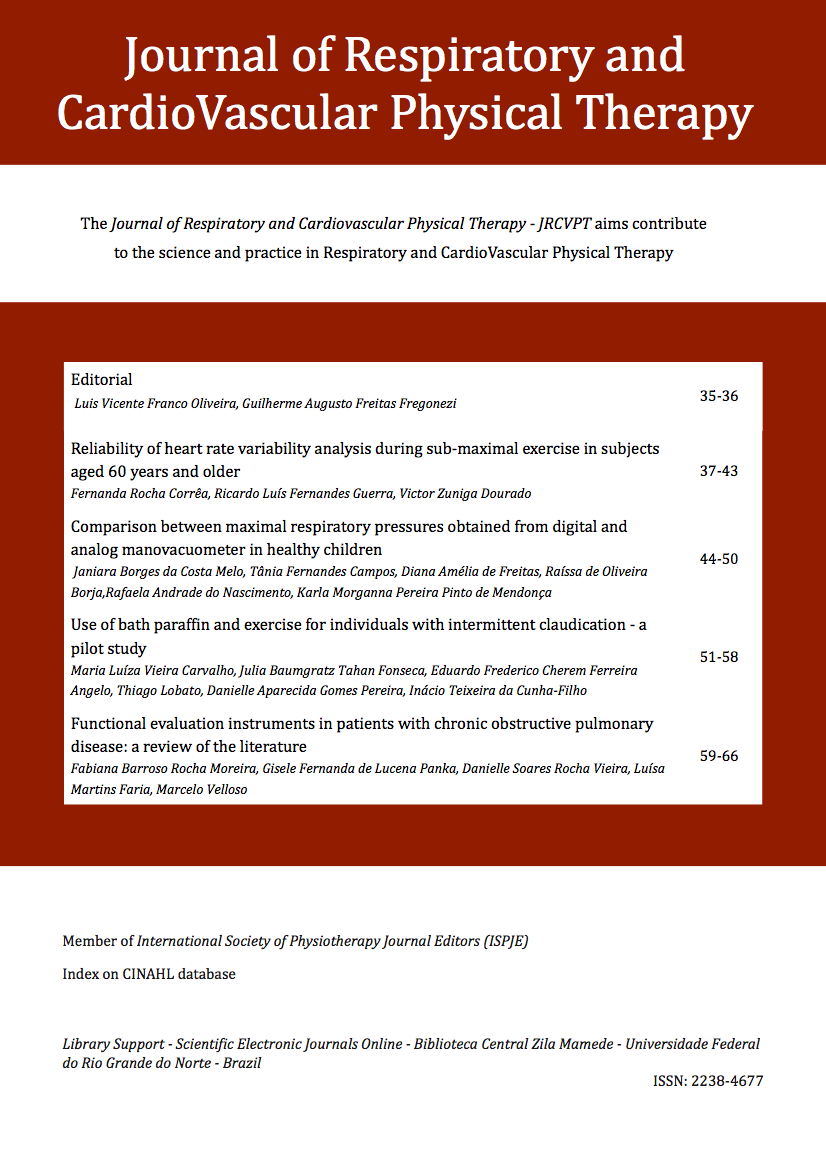Use of bath paraffin and exercise for individuals with intermittent claudication - a pilot study
Palavras-chave:
claudication, vascular, paraffin, exercise tolerance.Resumo
Background: Peripheral arterial obstructive disease's (PAOD) most common symptom is the Intermittent Claudication. The hot paraffin associated with physical exercise could be a possible support in the treatment of PAOD patients, since the amount of heat delivered to the tissues may potentially increase blood flow. Objectives: compare the indicators of functional capacity between a group of individuals with PAOD who underwent a combination of thermal stress and physical exercise, and another group of similar individuals treated only with physical exercise. Methods: Paraffin Group (PG) comprised of 10 individuals received thermal stress (hot compresses of paraffin) before physical activity. The control group (CG) of 9 participants was treated with physical activity alone. Shuttle-walking test (SWT), six-minutes walking test (6MWT) and ankle-brachial index (ABI) before interventions and after six weeks of training were assessed. Results: The mean age of the PG and for CG was 59.1 ± 10.41 and 68.89 ± 4.91 years (p = 0,019), BMI 27.54 ± 3,52 and 27.51 ± 2,07 (p=0,98) respectively. There was no statistically significant difference in the mean values of distance, time, speed or walking economy, both at symptom onset and at limiting symptom between groups during the SWT (p > 0,05). The change in distance measured during the 6MWT, both at symptom onset and at limiting symptom were not different between groups (p > 0,05).Conclusion: There was no statistically significantly difference in the indicators of functional capacity between PG and CG.
Downloads
Downloads
Publicado
Como Citar
Edição
Seção
Licença
Copyright Transfer Statement
The author(s) of the article, as specified here, hereby transfer(s) to the Revista de Fisioterapia Respirtória e CardioVascular (Journal of Respiratory and CardioVascular Physical Therapy) all copyright ownership rights, title and interests that the author(s) may have or may come to have in and to the article and any revision or version thereof, including, but not limited to, exclusive right to print, publish and sell the article anywhere in the world, in any language and in any media.
This agreement will be considered effective and valid if and when the article is accepted for publication.
If the article contains any copyright-protected material from a third party, the author(s) must obtain written permission to reproduce the said material in the article from the copyright holder and send it to the Revista de Fisioterapia Respirtória e CardioVascular (Journal of Respiratory and CardioVascular Physical Therapy).
The author(s) guarantee(s) the holding of proprietary rights to the article; not having granted or transferred any rights to the article to any other persons or entity; that the article is susceptible to the demand for rights by its author(s); not having infringed upon any author rights, trademark or patent; not having violated the right to privacy or publicity of any person or entity; that the article does not contain any defaming subject; that the factual statements made are true or are based on reasonably accurate research; and, finally, that, the author(s) has/have no reason to believe that any of the formulas, procedures or prescriptions contained in the article will cause damage if used or followed in accordance with the instructions and warnings contained in the article.
The author(s) will indemnify the Revista de Fisioterapia Respirtória e CardioVascular (Journal of Respiratory and CardioVascular Physical Therapy) against any costs, expenses, damages or liability that the Revista de Fisioterapia Respirtória e CardioVascular (Journal of Respiratory and CardioVascular Physical Therapy) may incur as a result of accidental omissions of these guarantees. These representations and guarantees may be extended to a third party by the Revista de Fisioterapia Respirtória e CardioVascular (Journal of Respiratory and CardioVascular Physical Therapy).
Date:
Note: Each author must individually complete and sign this form
1) Author:
Signature: _________________________________
2) Author:
Signature: _________________________________
3) Author:
Signature: _________________________________
4) Author:
Signature: _________________________________
5) Author:
Signature: _________________________________
6) Author:
Signature: _________________________________
7) Author:
Signature: _________________________________
8) Author:
Signature: _________________________________




 English
English Español (España)
Español (España) Português (Brasil)
Português (Brasil) Français (Canada)
Français (Canada)